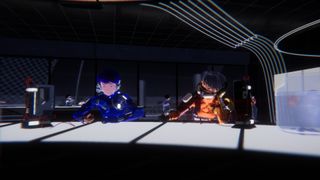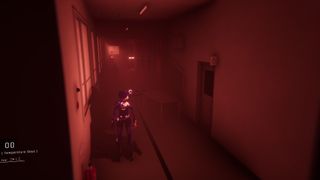A clone learns about individuality in experimental narrative game 1000xResist
I am not a number. Or a color-coded jumpsuit, for that matter.
Is throwing someone in at the deep end the best way to teach them to swim? Probably not, but it is the most fun. At least, for the observers. That's what 1000xResist does, opening in medias res and trusting you'll figure out how to float. It begins with one of the story's most dramatic scenes then flashes back to the events leading up to that moment, but what's really likely to confuse you is its setting. 1000xResist is the kind of science fiction that builds an entire future society out of projecting modern concerns to a distant point where everything has changed, with an entire history you get to puzzle out from context clues and ambiguous phrases.
I won't take the fun out of doing that for yourself, but I will briefly summarize the main points. At some point in the future a pandemic wipes out all but one human being, a solitary woman immune to the disease. She clones herself, building a community of survivors who, while genetically identical, develop different personalities thanks to their different life experiences, growing into roles their creator assigns them. By the time 1000xResist begins there's a whole civilization of these clones who worship the "Allmother" and live in an Orwellian underground bunker civilization where everyone wears color-coded jumpsuits.

You play a clone granted a snazzy blue jumpsuit and the function of Watcher, denoting your role as an observer—both of your sisters and the Allmother's memories, which Watcher explores like a sort of virtual reality. 1000xResist is a narrative game that changes its mechanics and viewpoint to suit each section of the story, so when you're reliving the Allmother's high school memories of the initial outbreak it becomes fixed-camera third-person like an old survival horror game. It feels like I'm back exploring Midwich Elementary in Silent Hill, even down to the barricaded dead end corridors, which suits the creepy tone of this chapter.
Later on it switches to first-person walking sim, and briefly a sidescroller. While exploring more fragmented memories it switches again and you cross floating islands of thought by grappling between highlighted target points, which is the only one that didn't work for me. Missing a target and plummeting into a void before restarting the whole section from a checkpoint felt too videogame-y for this particular vibe.
Mostly though, 1000xResist nails what it's going for—a blend of "big idea" sci-fi and coming-of-age story. As the Watcher you're growing into your position in a society that seems alien to us, the players, and by reliving the Allmother's memories you're seeing her grow up in a lost world that seems confusing to the clones, but is mostly just our familiar modern day. There's a pleasing symmetry to that.
As the child of Hong Kong immigrants in Canada, the young Allmother is worried about fairly mundane things even as a strange pandemic begins and news stories about people claiming to have encountered aliens spread through the background of her life. She's too busy to pay attention to all that, caught between her family's high expectations and her own attempts to fit in, which result in casual teenage cruelty directed at a Chinese immigrant student who gravitates to her. It's a kind of Do Clones Dream of Intergenerational Trauma?

The high school mood is mirrored in the parts of the story set in the future—a miniature society of clones who are as desperate to differentiate themselves from the pack but also fit in as any teenager. They adopt varying fashion styles and hair colors, lean into different skillsets and personas. Healer acts like a caring big sister while the clone in charge of defense, called Bang Bang Fire, spouts stoner philosophy and knock-knock jokes.
The biggest gaming news, reviews and hardware deals
Keep up to date with the most important stories and the best deals, as picked by the PC Gamer team.
By the end of the preview, 1000xResist leans back into horror. This time it's more cosmic horror, with an underground puzzle sequence that's reminiscent of Tomb Raider without the climbing and jumping. This is maybe halfway through the story and 1000xResist has already been three or four different games.

That's a good thing as far as I'm concerned. The studio behind it, Sunset Visitor, are new to game development, having begun in experimental theater and performing arts. 1000xResist feels like the creation of industry outsiders who are keen to break the rules but also have enough knowledge of the form to reference and build on existing work. That's a place some of the best indie games have come from. Disco Elysium, for instance, a game I plan to spend all of 2024 referencing, which was created by a collective of Estonian art punks. 1000xResist may not turn out to be a genre-defining masterpiece like that was, but it's definitely going to be a fascinating experiment in letting a story shape systems, and in seeing how well players can swim to keep up.
1000xResist is due out early in 2024 on Steam, GOG, and Epic.

Jody's first computer was a Commodore 64, so he remembers having to use a code wheel to play Pool of Radiance. A former music journalist who interviewed everyone from Giorgio Moroder to Trent Reznor, Jody also co-hosted Australia's first radio show about videogames, Zed Games. He's written for Rock Paper Shotgun, The Big Issue, GamesRadar, Zam, Glixel, Five Out of Ten Magazine, and Playboy.com, whose cheques with the bunny logo made for fun conversations at the bank. Jody's first article for PC Gamer was about the audio of Alien Isolation, published in 2015, and since then he's written about why Silent Hill belongs on PC, why Recettear: An Item Shop's Tale is the best fantasy shopkeeper tycoon game, and how weird Lost Ark can get. Jody edited PC Gamer Indie from 2017 to 2018, and he eventually lived up to his promise to play every Warhammer videogame.
Most Popular

